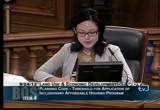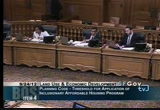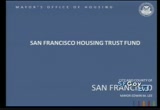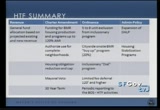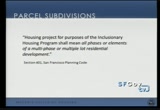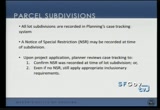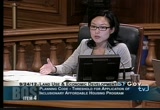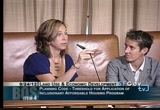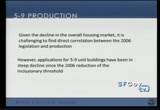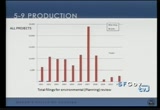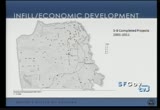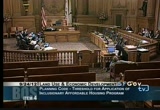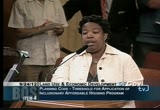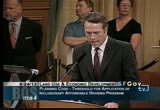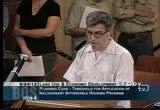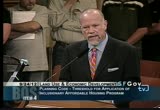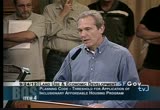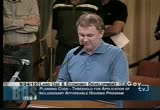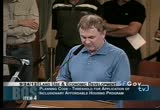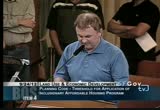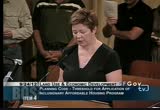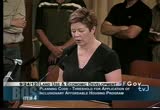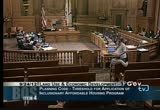tv [untitled] September 30, 2012 7:30am-8:00am PDT
7:30 am
a look back on this issue three years down the line. thank you. >> thank you. supervisor cohen. >> thank you very much. just wanted to publicly acknowledge they do believe that the amendments that supervisor chu are proposing certainly strike an appropriate balance between this and monitoring it and it's not contradictory of the city's production goals and like supervisor kim was speaking of, and i have been thinking a lot about this particular piece of legislation and to be honest i was uncomfortable and i didn't know how it would impact the southeastern neighborhoods and the strong desire to develop in that area, but looking at this and district ten i found there are few that would meet the size, zoning and financial requirements for the five to nine development, so i am
7:31 am
definitely going to be supporting this today and i don't believe we're moving the inclusionary requirement for the five to nine will impact the afforable housing in the city or compromise the neighborhoods and i will be mentioning this today. thank you mr. mar. >> thank you and i just wanted to thank everyone for building a big tent of support around the housing trust fund prop c as well and also the different builders and others to really come up with good ways to montheory while also stimulate up housing with the smaller projects as well, so i wanted to thank everyone for coming together on this one. so let me turn it back over to olson lee of the mayor's office on housing. >> okay. at this time dan adams from the mayor's office of housing will do the presentation
7:32 am
on the legislation, and he will try to address many of the questions that were raised by the supervisors and demonstrate the need to pass this legislation. dan. >> thank you. i'm going to give a very brief presentation which really serves to under score the very pertinent and comments that have been already put fort. i do have a four point. you have copies being distributed to you. there you go. simply put we're returning the threshold for the inclusionary requirement before it was 2006. it's a simple piece of legislation that just reverts us to our former standard and we're going to talk through about what we have seen or not seen over the last six years since the legislation was enacted and also -- i mean or furthermore one of the things as you have all noted since that time we have been engaged in
7:33 am
this trust fund proposal that and legislation is a part of that overall package. as we have already pointed out the housing trust fund includes the charter amendment on the november ballot and also a number of piece of legislation. this was it is first piece of legislation that would come before you for consideration outside of the charter amendment. we will be coming back to discuss a city wide buy up program as well as flexibility in the administering the requirements and legislation that will prompt the mayor's office for periodic reports and this the first of a package of legislative pieces. so today i'm going to talk about this -- what we call the five to nine legislation. one of the
7:34 am
concerns that was behind the original adjustment to the requirement was a risk of subdividing parcels in order to sort of gain the system and avoid the inclusionary requirement. we will talk about that. we will talk about the bmr production and other production and the potential to serve our in fill housing goals as well as commercial development goals. so first just talking about the risk of parcels subdivision. we feel like this concern that we haven't seen and sarah from the planning department can speak to the trend over housing over time. we haven't seen a lot of production of projects that have unit count or two below the threshold so we haven't seen this phenomenon be problematic but there are provisions in the code that allows the planning department to consider a
7:35 am
multi-phase, multi-parcel as part of a project and not beholden to the requirements of the inclusionary program. when they come into to subdivide the parcel the planner that takes that in has notice of special restriction. this would require the future development, be it multiple parcels, to attend to the requirements of the inclusionary program and to record that at that time and it's tracked in the planning department case tracking system so when the project -- later date if a project comes in for entitlement, approval and will say they know or apply the inclusionary options at that time so there is a tracking system in place.
7:36 am
>> supervisor kim. >> that was actually one of the concerns i had as the legislation was moving through the process over the summertime, so i was hoping you could explain again why it is in some cases planning do one of those and what is the difference? it seems either way it's going to get recorded but if they can't do a notice of special requirement could that take place and if that is an added layer of protection and one of the concerns is developers will separate them and build several residents and i know this is something planning has been working on and can you explain that and why it's not all done in all cases? >> yes, i can explain in detail and an apt question and we have that in place because the board recognize this is is a concern. the way that we would -- in any
7:37 am
case that we catch it when a subdivision comes before us it would fall before the threshold we always attach the notice of special restriction, so it isn't a question of when we would or wouldn't. the reason we mention the second which is when an actual project application comes in is we have a bake up. we have a. >> >> back up. we have a fails safe. and mistakes every so do often occur we have a backup system and reviewing the project we look at all cases filed recently and see a lot subdivision had been filed and occurred and therefore because the definition is for all phases of the project we could include the requirements without that. it's not a question of which you choose. it's we have a backup if the first doesn't occur. >> thank you. >> thank you for that question. thank you. so this next slide
7:38 am
is sort to scale the issue. while five to nine we feel is important segment of the how longing production that happens in the city and talk about the housing goals. it is a small percentage of the production over the last ten years and represents 3% of the units produced in the city and that gives you a sense of the scale of the issue. in terms of production since the change in the inclusionary requirement while it is difficult to ascribe a precise or exact role to that legislation given that we experienced large declines in the housing market over the last half decade. we have seen a considerable decline for applications of this size of development. this grass shows
7:39 am
a rather precipitous decline in applications and you can see from 2001 until 2011 where 2006 moving forward we see quite a significant drop off in the number of applications. this is compared to the overall pipeline . the red bars are numbers of units. you see a spike in 2007 and a drop off in 2008. this correlates much more closely to the overall crash in the market as opposed to the reduction in five to nine. we have seen similar reductions in other small scale developments but we see acute decline in applications in the five to nine level. now, what is certainly true is that five to nine unit buildings do not represent a significant -- that you see
7:40 am
predominant in south of market or mission bay so the smaller five to nine developments is a kind of development, a product that can be produced throughout the city, and thereby help meet our in fill housing goals. this is from the housing development that speaks to this neighborhood's sensitivity issue and infrastructure and apply these projects throughout the city indeed and this map which is a map of five to nine
7:41 am
completed projects since 2001 you see quite a broad distribution across the city which is something that we ideally like to encourage moving forward. in addition a number of these projects are located on commercial corridors. there is ones on mission and terra baland when the initial analysis of vacant parcels that can along the districts and encouraging five to nine unit production but reducing the inclusionary requirement there is economic potential in this adjustment to the current standards. so in conclusion five to nine unit buildings are a small but important part of the residential fabric. we feel they can meet the in housing goals and limited economic
7:42 am
goals. five to nine buildings do not represent significant bmr production for the city and there are tools in place to prevent for lot subdivision. so that concludes my presentation. i am happy to answer any questions. >> i see no questions. thanks mr. adams. i will turn it back over to mr. chiu. >> thank you. let's go to speaker cards and we have two cards and let's start with the first two and if others wish to follow if you could line up on the right hand side of the board chamber. >> good afternoon supervisors. i am it meeba moss. i am spur and i wanted to come in and speak on behalf of this piece of legislation and many of you
7:43 am
have talked about why this is so critical to the housing trust fund package and one of the stakeholders that has been a part of that process from the beginning i want to under score the importance of this piece of legislation as well the additional pieces of legislation that will be coming before you in the months to come. this was a consensus measure of the we were proud we were able to work with the community stakeholders and all of the members of the work working group that we responded to the housing crisis we're are experiencing in san francisco as well as ways to stimulate, market rate production housing as well and this is just the very beginning of what we hope to be a very successful measure, certainly in november, but also really contributing to increasing housing production in san francisco, so i ask the
7:44 am
committee put it forth with a positive endorsement and we will be back. thank you very much. >> thank you. let's hear from our next speaker. i'm an attorney and here to express my support for raising the threshold and you have heard so many good reasons already, and more to come. i just limit my comment to the fact that there aren't -- very few if any jurisdictions of san francisco's size that have such a low threshold for inclusionary housing and this would bring this city back in line with other jurisdictions of comparable size. thanks very much. >> good afternoon supervisors. ferdinanda with the council on
7:45 am
community organizations. thank you very much for bringing this piece of legislation forward. we were part of the working group that developed the housing trust fund along with other folks who are here in the audience. my colleague is bringing up copies of a letter they think the city may have forwarded to you all that was on community organizations to the planning commission when this was heard before them basically expressing our support for the measure and raising history around the measure and around why in 2006 the measure -- the inclusionary ordinance was changed and it was largely a piece of legislation sponsored by supervisor mok goldric and closing loopholes and one mr. adams spoke about and division of subproperties and second the concern that developers might not be building to the allowable zoning and
7:46 am
wasting the resources to up zone our properties. as dan adams said earlier this is not necessarily respond to concerns about not needing numbers of bmr units but rather the community's desires to keep integrated neighborhoods with mixed use buildings. there are different ways to deal with this. the nsr's around subdivisions is one way. i will contradict the attorney from earlier. some cities have lower thresholds like san francisco. san diego goes down to two units and above to kickoff an inclusionary, but use that with sort of a graduated fee structure. that doesn't mean at two units you have to build 1bmr, but there's were largely theoretical problems. back in 2006 i
7:47 am
believe there were two examples and one in district ten and nine and raised concerns from community members. as dan adams pointed it's not a large number but the amendment introduced earlier today allows the board to review and see if the theoretical problems do become loopholes that maybe abused by them. we believe this is an appropriate solution to 2006 that resulted in changing the inclusionary threshold so with that history and context i want to say we support this legislation. thank you supervisors. >> thank you. next speaker. >> good afternoon. tim colin on behalf of the housing coalition. we were pleased too to be in the stakeholder discussion on this and we want to commend in particular the work that the mayor did in bringing a very large tent -- creating a tent
7:48 am
with a diversity of stakeholders. it's rare. it doesn't happen often enough and the discussions were productive and open and went along ways to create this. i want to commend in particular the mayor's office housing, the terrific work they have done. this is a good policy. what it has in effect a shaking of hands across the whole spectrum. this is a sensible idea. if san francisco will every address the housing challenges it faces, serious ones, we will have to construct higher levels of housing of this type. it's the housing that we and appropriate with neighborhoods and fits in well and we have to create the conditions which builders want to build this and we believe this is a great step in the
7:49 am
right direction and hope that you move it forward. thank you. >> good afternoon members of the board. i want thank the folks in line for giving me cuts. i wanted to follow up with my colleague. i am peter and he made reference to a letter. we submitted this back in mid-august so i have copies of it here. i know we sent it to you and we have been supportive of this legislation and broad strokes from the beginning. that hasn't changed. the technical issues we worked with the city staff on that and at least with the three year report back it gives us time to see if there are unintended consequences and those are smart mearments and we are supportive again of your careful work here board members and i will leave these up on the rail if you like. thanks. >> next speaker.
7:50 am
>> supervisors good afternoon. richie hart, residential business association and myself and my fellow members will speak and give a history and the part in the housing trust fund to provide some background. in 2006 the committee was formed. no small builders were informed and made up of nonprofits and large developers. supervisors it's important to state that the state did not include any member or representative from the small building committee at this time. as a result the following recommendations were recommended forward by the advisory committee. to include on site requirements towp 15% and off sight or in lieu up to 20% and
7:51 am
include five units or more and provision for off site to be constructed in 1 mile aideus of that project. while this was stub stated by studies by kaiser madison and the smaller was 100 plus unit project, and it's inconceivable by the committee and planning department can make recommendations for inclusionary housing requirement on five to nine housing projects and in fact they were never studied and the nearest size project was 100 units. the economy of scale and between that are incomparable and supervisors just to hold up the two pieces of paper. this is five to nine and this is 100 project. and the housing and yet we don't study the five to nine. we study a 100 unit
7:52 am
project. the scale is not close. we should have studied the five to nine units. we didn't. we studied the 100 units, the smallest project and to continue my speech supervisors. with this flawed analysis and lead to one success in the city since the policy's conception in 2006 and i repeat this failed policy has one successful project. thank you supervisors. >> supervisors, mayor lee and the members of the supervisor recognized to replace lost gqnresources for this and continuous and reliable revenue stream and stimulus for depressed local housing
7:53 am
industry. the mayor had a big working group of the stakeholders. the group of industry specialists were called upon based on experience and industry sector expertise and builders represented by members of the council of community housing and of the residential builders association. they represented the local medium and small builders. in short it was a representative group of stakeholders. despite conflicting priorities they came together with a common cause and all impacted with prolongd and severe economic depression in san francisco's construction industry and by burdensome policies drafted during enormous economic times and not responsive to the crisis in
7:54 am
2008. while this group hasn't all achieved consensus they realized working together was the only way to move the policies forward and in turn provide much needed housing in the city. i would like to point out some of the socioeconomic projects of the five to nine projects part of the housing program. these builders are best characterized as small traditional mop and pop businesses. they. >> >> hire locally and supply companies and hire trances men. they shop here and go to school here. a large part are immigrants. the city has a life community yet the small to medium builder is rarely treated this way. part of the american
7:55 am
dream iseclimb the later and achieve. in the construction industry they work with someone else and after they learn a trade or skill they move on. the five to nine projects are a crucial rung in this ladder and by impacting this category you take a rung out and prohibiting advancement in the construction field. our fellow members would speak to this in more detail and we appreciate your support and we support this legislation and the amendment. thank you. >> good afternoon supervisors. my name is n on el carter and one of the owners of a business in san francisco. we are a solar design company. we hire from local training programs such as city build, goodwill and neighborhood design. the five
7:56 am
to nine unit buildings are pretty much perfect and multi-family buildings. any large buildings are constricted by roof space and the five to nine are critical for our business. we have -- we can all fit 100% of the gas consumption of the buildings and off set up to 90% of [inaudible] conassumptions in these buildings and thank you for your support. >> good afternoon supervisors. my name is shawn gorm an. i am an architect. i have been practicing in san francisco for almost 25 years. a lot of the work that i have done over the years has focused on the residential especially small projects and when i say small generally under ten units and it's pretty impressive in terms
7:57 am
of the decline in these types of projects since 2006 as was represented in earlier testimony. over that period i really have seen nothing like it, and there's definitely a correlation regarding the bmr requirement, and these projects are critical in terms of the urban in fill of the existing zoning in san francisco. you have neighborhood commercial zones which support the neighborhood commercial businesses are also supported by additional residential housing in those neighborhoods, and this type of housing is tailor made for those areas and it's not úçñ getting built. all we're seeing now is the huge projects going in south of market and thereabouts but you're seeing very little additional housing
7:58 am
stock along the neighborhood transit corridors which i think is just a waste and we really need to change policy and i think this proposed legislation is a huge step in that direction. thank you for your support. >> good afternoon supervisors. i am jim lavick and a small flooring contractor. we do 90% of the business for small and medium size builders. when this legislation was passed back in 2006 probably 35 to 40% of our business was under ten unit buildings and along with what is going on in the economy since then -- i mean you can imagine what it's like to do business in the city but elsewhere and 90% of our business is done in the city. supervisor kim said that legislation like this passes
7:59 am
and it helps the small business in the city. we used to employ 48 people, 49 people back in 2004. we're now 12 so whatever you people can do to try to boost our business it would be graciously appreciated. thank you very much for your support. >> good afternoon chairman mar, supervisors, and steven mc clory. i am here today to congratulate everyone on getting behind the new rules for the five to nine unit projects. i spoke with a few people today that work on our jobs and asked them when is the last time they were on one of those projects? and literally no one could remember being on a five to nine unit project and the numbers here today show that the reason is they
139 Views
IN COLLECTIONS
SFGTV: San Francisco Government Television Television Archive
Television Archive  Television Archive News Search Service
Television Archive News Search Service 
Uploaded by TV Archive on

 Live Music Archive
Live Music Archive Librivox Free Audio
Librivox Free Audio Metropolitan Museum
Metropolitan Museum Cleveland Museum of Art
Cleveland Museum of Art Internet Arcade
Internet Arcade Console Living Room
Console Living Room Books to Borrow
Books to Borrow Open Library
Open Library TV News
TV News Understanding 9/11
Understanding 9/11